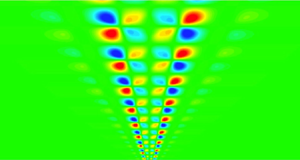Published online by Cambridge University Press: 04 August 2021

A large-Reynolds-number asymptotic reduction of the Navier–Stokes equations capable of describing a locally periodic vortex-wave array and the associated large-scale variation of the mean-shear velocity field first suggested in Hall (J. Fluid Mech., vol. 850, 2018, pp. 46–82) is extended. The sustaining process of the locally periodic coherent structures is based on the vortex-wave interaction theory of Hall & Smith (J. Fluid Mech., vol. 227, 1991, 641–666), wherein two-dimensional roll–streak fields are supported by localised nonlinear self-interactions of three-dimensional waves that are largest in size within critical layers of the streak field. The variation of the mean velocity is made possible by incorporating a slow change to the mean profile using a Wentzel–Kramers–Brillouin-type approach. As the first extension, we demonstrate that the local structure corresponds to the asymptotic limit of computations in a shearing box. A variety of solutions with different symmetry properties are found via the hybrid numerical asymptotic approach of Blackburn, Hall & Sherwin (J. Fluid Mech. vol. 721, 2013, 58–85). Moreover, some solutions show generic flow features such as uniform momentum zones and spatial intermittency known to occur in near-wall turbulent boundary layers. We extend the vortex-wave interaction array theory to show that, in addition to a Reynolds-averaged-Navier–Stokes-type relationship between the large-scale vertical variation of the mean flow and local roll–streak scale, a higher-order analysis gives a second constraint on the slow-scale dynamics. Those constraints are used for the first time to derive the logarithmic law of the wall through a closed asymptotic analysis of self-similar local coherent structures, consistent with the attached eddy hypothesis.